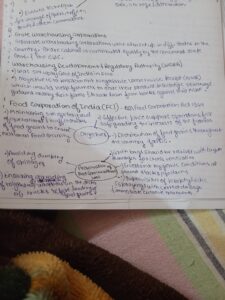Analyze how the Public Distribution System’s (PDS) digital transformation in India has assisted in resolving the issues that it faces. (Answer in 150 words)
Model Answer Introduction The Public Distribution System (PDS) is a crucial mechanism for ensuring food security in India, especially for vulnerable populations. The Food Corporation of India (FCI) plays a vital role in the procurement, storage, and distribution of food grains under PDS. Reforms inRead more
Model Answer
Introduction
The Public Distribution System (PDS) is a crucial mechanism for ensuring food security in India, especially for vulnerable populations. The Food Corporation of India (FCI) plays a vital role in the procurement, storage, and distribution of food grains under PDS. Reforms in FCI have significantly improved the efficiency of PDS and strengthened food security for millions.
Reforms in FCI and Their Impact on PDS Efficiency and Food Security
1. Targeted Approach
- FCI reforms have helped make the PDS more targeted, ensuring that food subsidies reach the deserving populations.
- Illustration: Around 4.7 crore ghost/duplicate ration cards, benefitting nearly 17 crore “undeserving” individuals, were removed, making the system more effective.
2. Digitization
- The FCI has implemented technology-driven reforms like Aadhaar-based identification and Point-of-Sale (PoS) machines, improving the efficiency of beneficiary identification.
- Fact: Over 92% of ration cards have been digitized, reducing errors and fraud.
3. End-to-End Computerization
- Complete computerization of PDS operations, from procurement to distribution, has minimized manual processes and enhanced supply chain efficiency.
- This ensures timely food grain delivery and minimizes paperwork.
4. Buffer Stock Management
- FCI now uses scientific methods to maintain buffer stocks, ensuring that adequate food grains are available during emergencies or supply disruptions.
- Example: During the COVID-19 pandemic, buffer stock management ensured continuous food availability, preventing food insecurity.
5. Decentralization
- The procurement process has been decentralized, allowing state governments to manage food grains more efficiently, addressing local challenges.
- This reform gives states more control over distribution and management, improving responsiveness.
6. Fortification and Nutrition
- FCI has initiated food grain fortification, adding nutrients to staples like rice and wheat to combat malnutrition.
- This is especially important for vulnerable populations, contributing to better health outcomes.
7. Online Monitoring and Transparency
- Reforms have enabled real-time monitoring of PDS operations, improving transparency and reducing corruption.
- Impact: This real-time data helps in prompt interventions, ensuring the system functions smoothly and equitably.
8. Supply Chain Optimization
- FCI reforms have improved the logistics of food grain transportation, storage, and distribution. This has minimized wastage and reduced delays in delivering food grains to beneficiaries.
9. Single Window System
- The introduction of a single window system for procurement, allocation, and distribution processes has simplified administrative procedures, contributing to greater PDS efficiency.
Way Forward
- Improve Beneficiary Identification: Continue refining the identification mechanisms to ensure that food subsidies reach only the most deserving individuals.
- Strengthen Supply Chain Infrastructure: Invest in modern storage and transportation facilities to reduce wastage and ensure timely delivery.
- Enhance Nutritional Diversity: Incorporate more nutritious food items like protein sources and fruits in PDS to address malnutrition.
- Flexible System: Ensure the PDS can adapt quickly to changing conditions, such as economic shifts or natural disasters.




The Public Distribution System (PDS) has evolved as a system of management of scarcity through the distribution of food grains at affordable prices. It has the objective of providing food and nutritional security, stabilizing food prices, redistribution of food, and maintaining buffer stock. HoweverRead more
The Public Distribution System (PDS) has evolved as a system of management of scarcity through the distribution of food grains at affordable prices. It has the objective of providing food and nutritional security, stabilizing food prices, redistribution of food, and maintaining buffer stock.
However, the PDS in India has been beset with certain challenges, including:
To address these issues, there has been a push towards digitizing the PDS over the last couple of years. The initiatives include linkage with the Aadhaar card and maintenance of digital records at Fair Price Shops.
These initiatives have led to the following impact on the Public Distribution System:
Providing better connectivity, a faster network, installing more devices per shop, establishing additional call centers to address technical queries, analyzing the technology adoption behavior for improved policies, and promoting digital literacy can further help address the issues pertaining to the PDS.
See less